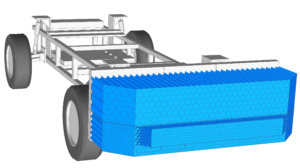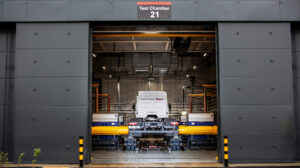Industry News
New LS-Dyna barrier model enhances China NCAP side-impact tests
The Oasys LS-Dyna Environment introduces a new side-impact barrier shell model specifically designed for the China NCAP Protocol. The SC-MDB C-NCAP follows the specifications outlined in the C-NCAP Management Rules (2024 edition) and will be used in the 2024 China New Car Assessment Program (C-NCAP) for its side-impact testing protocol.
The SC-MDB barrier’s six honeycomb blocks have been meticulously validated to comply with C-NCAP SC-MDB specifications. This validation process involved calibrating the LS-Dyna model using simulation results from a 40km/h dynamic impact against a rigid wall.
Webasto chooses Monolith as AI partner for EV battery validation
Global automotive systems supplier Webasto has selected Monolith as its AI partner for electric vehicle battery validation. Webasto’s R&D team is utilizing Monolith’s AI software to enhance the efficiency of battery module and pack testing. Over the next year, the two companies will collaborate on various projects, initially focusing on optimizing battery pack screw tightening – a critical factor influencing battery performance and degradation.
Dr Richard Ahlfeld, CEO and founder of Monolith, commented on the partnership, “Our work with Webasto sets a new standard for how AI can be used to improve processes and products.
Philippe Krief named new CTO of Renault Group
Starting from September, Philippe Krief, who is currently CEO of Alpine, will step into the additional role of chief technology officer at Renault Group, while continuing his duties with the Alpine brand. He succeeds Gilles Le Borgne, who has transitioned to a strategic advisory role for CEO Luca de Meo.
As the new CTO, Krief will oversee all of Renault Group’s engineering activities and resources, reporting directly to de Meo. Krief’s extensive background, particularly his tenure as director of engineering at Ferrari, equips him well for this role.
New UK powertrain testing facility opened by Cummins
A US$16.8m (£13m) powertrain test center has opened at Cummins’ Darlington campus in the UK. This facility will be crucial for developing a range of powertrain products from both Cummins and its subsidiary, Accelera. It will facilitate the testing of full powertrains using various fuels, including advanced diesel, natural gas, zero-carbon hydrogen and battery-electric technologies. The facility will also support the development of ICEs, fuel cells, batteries and crucial components such as axles and e-axles.
The sophisticated 738m2, two-story facility is equipped with cutting-edge testing technology such as advanced simulation capabilities for road grades, load and wheel slip and robotic driving systems capable of handling both manual and automatic transmissions.
VI-grade introduces virtual proving ground for VI-WorldSim
VI-grade, a provider of simulation-driven vehicle development solutions, has developed a virtual proving ground for VI-WorldSim, a traffic simulator.
The VI-grade Virtual Proving Ground is a digital testing facility designed to meet the needs of automotive engineers and researchers. It features testing scenarios that are designed to reduce development time and costs while improving vehicle quality and safety.
The facility includes a high-speed ring, which is an 8.6km track with four lanes and a maximum banking angle of 11°, deigned for high-speed testing and aerodynamic evaluations.
Bosch develops test bench for measuring brake emissions under Euro 7 standards
German engineering and technology company Bosch is using a test bench to measure particle emissions from brake pads and discs, aligning with the upcoming Euro 7 standards.
The new Euro 7 legislation, set to take effect in November 2026, will introduce particle emission limits for non-exhaust sources, including braking systems and tires. This legislation will apply to newly registered vehicle types and will later extend to the aftermarket.
In preparation for these standards, Bosch has equipped a brake test rig with new measurement technology, designed for high-precision assessments of total emissions and particle size distribution during test cycles.
Dubai completes initial tests on driverless trucks
The United Arab Emirates has successfully completed initial tests for its first driverless trucks, conducted by logistics and aviation hub Dubai South and local company Evocargo.
Following an agreement signed in December 2022, the Evocargo N1, an unmanned electric vehicle, was tested on a set route within the Dubai South logistics district, operating alongside pedestrians, automobiles and trucks.
The vehicle’s automated functionality was assessed, including its array of cameras and ultrasonic sensors that provide 360° visibility.
BMW and DeepDrive to field test a dual rotor electric motor
BMW Startup Garage and Munich-based R&D company DeepDrive are set to begin road-testing an electric motor featuring dual rotor technology.
The Startup Garage is a BMW Group program that evaluates potential startups as suppliers and long-term partners of the company. Following a successful pilot project and promising test rig results, BMW Group and DeepDrive will now proceed with field tests for the electric motor. Various versions of the new drive will be installed in BMW Group models to evaluate their performance on the road.








